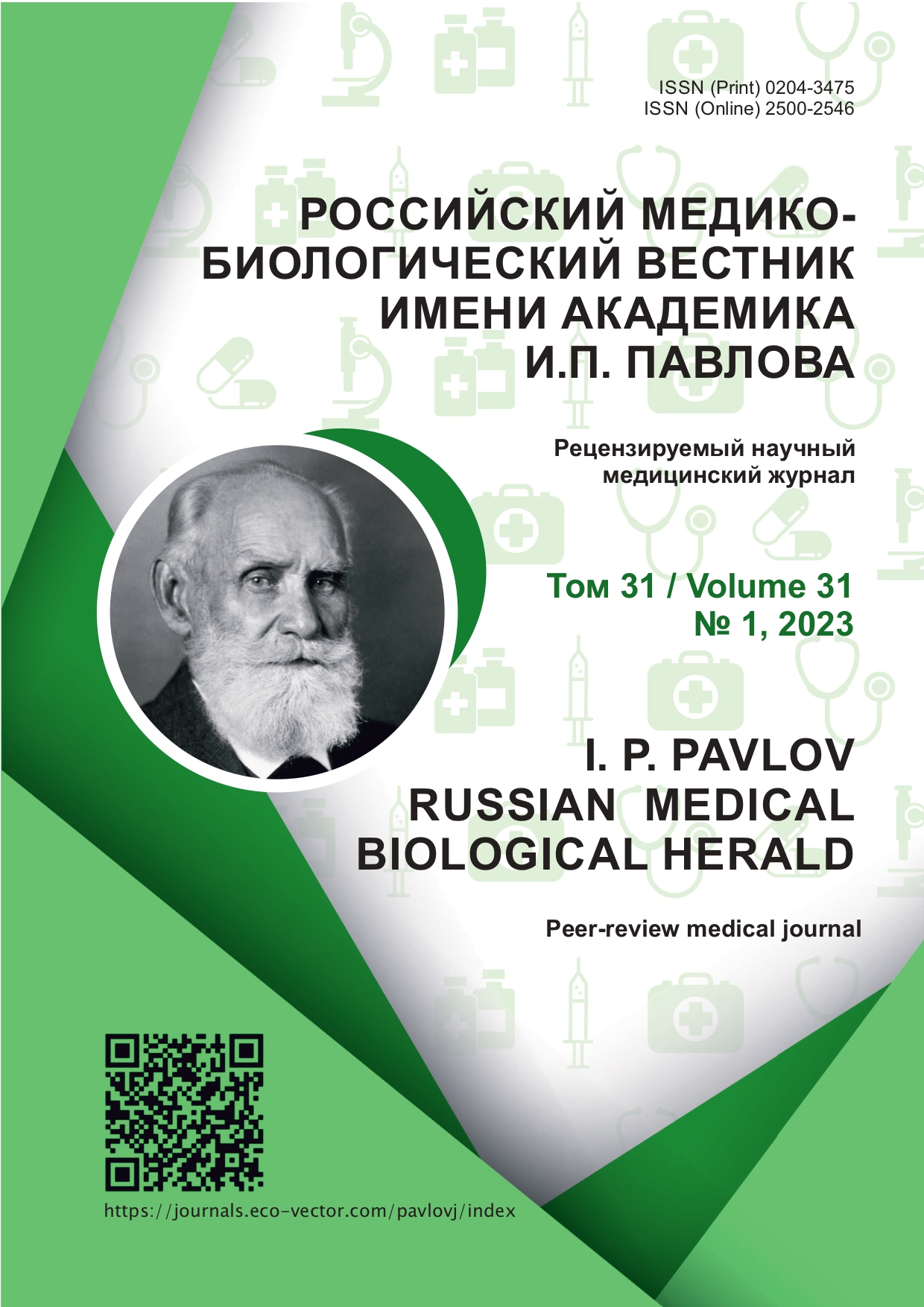Systemic Inflammatory Response Syndrome and Serum Procalcitonin in Odontogenic Maxillofacial Infection
- 作者: Kabanova A.A.1, Pokhoden'ko-Chudakova I.O.2, Kabanova S.A.1
-
隶属关系:
- Vitebsk State Order of Peoples’ Friendship Medical University
- Belarusian State Medical University
- 期: 卷 31, 编号 1 (2023)
- 页面: 119-125
- 栏目: Original study
- ##submission.dateSubmitted##: 14.04.2022
- ##submission.dateAccepted##: 22.09.2022
- ##submission.datePublished##: 03.04.2023
- URL: https://journals.eco-vector.com/pavlovj/article/view/106281
- DOI: https://doi.org/10.17816/PAVLOVJ106281
- ID: 106281
如何引用文章
详细
INTRODUCTION: The systemic inflammatory response syndrome (SIRS) is a progressive, pathophysiological process which may be caused by a variety of clinical precursor events including local or generalized infection, or non-infective inflammatory process.
АIM: To determine the development of systemic inflammatory response syndrome (SIRS) and serum procalcitonin level in patients with odontogenic infection of the maxillofacial area.
MATERIALS AND METHODS: The prospective observational study evaluated on 158 medical patients from 2015 to 2018 at the Department of maxillofacial surgery, Faculty of Stomatology, Vitebsk state medical University. The patients were divided into 3 groups: 1 group (96 people) had acute purulent odontogenic osteomyelitis of mandible complicated by the cellulitis of one space cellular spaces, group 2 (36 patients) had acute purulent odontogenic osteomyelitis of mandible complicated by the cellulitis of 2–4 cellular spaces, group 3 (26 people) — had acute purulent odontogenic osteomyelitis of the mandible complicated by Ludwig's angina. Blood tests of all patients were performed. Based on the blood test, breath rate, heart rate and body temperature SIRS was determined.
RESULTS: Acute odontogenic osteomyelitis, complicated by cellulitis, is characterized by the development of SIRS. In case of one cellular space cellulitis SIRS developed in 9.0% of patients, in case of 2–4 cellular spaces cellulitis — in 36.0%, in case of Ludwig's angina — in 80.0%. PCT blood level in healthy group was 0.009 (0.006–0.018) pg/ml. All patients’ groups had significantly higher PCT blood level compared with the healthy group: 1 group — 0.034 (0.019–0.050) pg/ml, U = 23, р = 0.01; 2 group — 0.11 (0.06–0.24) pg/ml, U =12, р = 0.003; 3 group — 0.41 (0.30–1.15) pg/ml, U = 17, р < 0.001.
CONCLUSION: Odontogenic maxillofacial infection is accompanied by SIRS. The search for significant diagnostic criteria for the development of life-threatening conditions should continue.
全文:
作者简介
Arina Kabanova
Vitebsk State Order of Peoples’ Friendship Medical University
编辑信件的主要联系方式.
Email: arinakabanova@mail.ru
ORCID iD: 0000-0002-0121-1139
SPIN 代码: 8930-3890
MD, Dr. Sci. (Med.), Associate Professor
白俄罗斯, VitebskIrina Pokhoden'ko-Chudakova
Belarusian State Medical University
Email: ip-c@yandex.ru
ORCID iD: 0000-0002-0353-0125
SPIN 代码: 9486-9067
MD, Dr. Sci. (Med.), Professor
白俄罗斯, MinskSvetlana Kabanova
Vitebsk State Order of Peoples’ Friendship Medical University
Email: chlx.vgmu@mai.ru
ORCID iD: 0000-0001-8165-7570
SPIN 代码: 4916-6722
MD, Cand. Sci. (Med.), Associate Professor
白俄罗斯, Vitebsk参考
- Bone RC, Balk RA, Cerra FB, et al. Definitions for sepsis and organ failure and guidelines for the use of innovative therapies in sepsis. The ACCP/SCCM Consensus Conference Committee. American College of Chest Physicians/Society of Critical Care Medicine. Chest. 1992;101(6):1644–55. doi: 10.1378/chest.101.6.1644
- Davenport EE, Burnham KL, Radhakrishnan J, et al. Genomic landscape of the individual host response and outcomes in sepsis: a prospective cohort study. The Lancet. Respiratory Medicine. 2016;4(4):259–71. doi: 10.1016/S2213-2600(16)00046-1
- Kaukonen KM, Bailey M, Pilcher D, et al. Systemic inflammatory response syndrome criteria in defining severe sepsis. The New England Journal of Medicine. 2015;372(17):1629–38. doi: 10.1056/NEJMoa1415236
- Singer M, Deutschman CS, Seymour CW, et al. The Third International Consensus Definitions for Sepsis and Septic Shock (Sepsis-3). JAMA. 2016;315(8):801–10. doi: 10.1001/jama.2016.0287
- Sheikh Z, Tan ET, Ifedayo S, et al. The role of sepsis screening, SIRS and qSOFA in head and neck infections: An audit of 104 patients. Clinical Otolaryngology. 2021;46(6):1273–7. doi: 10.1111/ coa.13828
- Jiang J, Yang J, Mei J, et al. Head-to-head comparison of qSOFA and SIRS criteria in predicting the mortality of infected patients in the emergency department: a meta-analysis. Scandinavian Journal of Trauma, Resuscitation and Emergency Medicine. 2018;26(1):56. doi: 10.1186/s13049-018-0527-9
- Askim А, Moser F, Gustad LT, et al. Poor performance of quick-SOFA (qSOFA) score in predicting severe sepsis and mortality — a prospective study of patients admitted with infection to the emergency department. Scandinavian Journal of Trauma, Resuscitation and Emergency Medicine. 2017;25(1):56. doi: 10.1186/s13049-017-0399-4
- Seo MH, Choa M, You JS, et al. Hypoalbuminemia, Low Base Excess Values, and Tachypnea Predict 28-Day Mortality in Severe Sepsis and Septic Shock Patients in the Emergency Department. Yonsei Medical Journal. 2016;57(6):1361–9. doi: 10.3349/ymj.2016.57.6.1361
- Mustafić S, Brkić S, Prnjavorac B, et al. Diagnostic and prognostic value of procalcitonin in patients with sepsis. Medicinski Glasnik. 2018;15(2):93–100. doi: 10.17392/963-18
- Ortiz R, Espinoza V. Odontogenic Infection. Review of the Pathogenesis, Diagnosis, Complications and Treatment. Research Reports in Oral and Maxillofacial Surgery. 2021;5(2):055. doi: 10.23937/2643-3907/1710055
- Weise H, Naros A, Weise C, et al. Severe odontogenic infections with septic progress — a constant and increasing challenge: a retrospective analysis. BMC Oral Health. 2019;19(1):173. doi: 10.1186/s12903-019-0866-6
- Kim J–K, Lee J–H. Clinical utility of procalcitonin in severe odontogenic maxillofacial infection. Maxillofacial Plastic and Reconstructive Surgery. 2021;43(1):3. doi: 10.1186/s40902-020-00288-x
- Chakraborty RK, Burns B. Systemic Inflammatory Response Syndrome. StatPearls [Internet]. Treasure Island (FL): StatPearls Publishing; 2021. Available at: https://www.ncbi.nlm.nih.gov/books/NBK547669/. Accessed: 2022 April 13.
- Suárez A, Vicente M, Tomás JA, et al. Cervical necrotizing fasciitis of nonodontogenic origin: case report and review of literature. The American Journal of Emergency Medicine. 2014;32(11):1441.e5–6. doi: 10.1016/j.ajem.2014.04.018
- Silva ML, Ribeiro AF, Sato FRL, et al. Prevalence of the systemic inflammatory response syndrome in patients who underwent orthognathic surgery. Oral and Maxillofacial Surgery. 2018;22(2):193–6. doi: 10.1007/s10006-018-0692-z
- Byers J, Lowe T, Goodall CA. Acute cervico-facial infection in Scotland 2010: patterns of presentation, patient demographics and recording of systemic involvement. The British Journal of Oral & Maxillofacial Surgery. 2012;50(7):626–30. doi: 10.1016/j.bjoms.2011.11.013
- Shaikh N, Borrell JL, Evron J, et al. Procalcitonin, C-reactive protein, and erythrocyte sedimentation rate for the diagnosis of acute pyelonephritis in children. The Cochrane Database of Systematic Reviews. 2015;1(1):CD009185. doi: 10.1002/14651858.CD009185.pub2
- Bertolus C, Schouman T, Aubry A, et al. Is procalcitonin a useful biomarker for the risk stratification of facial cellulitis? Journal of Cranio-Maxillo-Facial Surgery. 2016;44(8):995–7. doi: 10.1016/j.jcms.2016.05.023
补充文件









